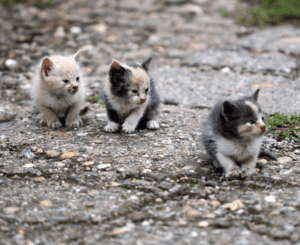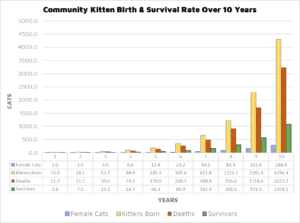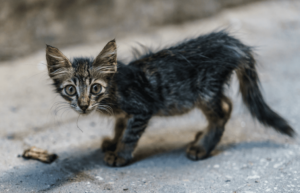Community Kittens are Struggling
Those who are active in animal welfare know the all too familiar warning; “Kitten Season is coming.” Even after recruiting volunteers, supporting Trap-Neuter-Return programs, and engaging the community with educational campaigns, it still feels impossible to be fully prepared for the annual population explosion. Nevertheless, there is so much you can do as a cat lover and animal welfare advocate to support our beloved community cats and kittens, local shelters, rescues, and TNR organizations in saving lives during this crucial time.
What is Kitten Season?
Kitten Season occurs between March and October, depending on the weather in your area. Long, warm days and a greater access to food creates an ideal environment for breeding. Las Vegas’s long stints of warmer weather makes for longer Kitten Seasons than in other, colder regions where finding warmth and food takes priority over breeding.
With access to food, shelter, and unneutered males, a female cat can:
- Go into heat and become pregnant as early as five months old, with a gestation period of just two months
- Have three to four litters per year
- Have on average four to six kittens per litter
- Become pregnant again within a few weeks of giving birth, even while still nursing
This means that after just about three months of the first litter being born, a mama cat can give birth to another litter. By the time a female has had three litters back-to-back, her first litter is already old enough to begin their own cycle of breeding.
Once these kittens are brought into the world, the heartbreaking struggle for survival can be brutal for these free-roaming babies.

Surviving as a Community Kitten
There are so many things a community cat has to fight for to survive; shelter, food, warmth, territory. At the same time, they are still threatened by predators, vehicles, illness and disease, and even people who see them as pests and would harm them.
Many community cats can rely on caretakers: cat lovers who keep a close eye on the health of the cats in their neighborhood, provide them with food and water, and even build them cat shelters in harsh months. Some are not so lucky. The very sad truth is that free-roaming kittens have an incredibly high mortality rate that can reach even 75%.
This chart details, over ten years, how many kittens are likely to be born starting with just one female cat. The data is based on females giving birth to three litters per year with five kittens per litter, half being female. Given the standard mortality rate of these kittens and all of the hardships they and the mother will likely endure, these numbers may be generous when it comes to kitten survival. The huge amount of kittens that can be born from such a small population of females is staggering. The amount that doesn’t survive is heartbreaking.

It’s devastating to think that only one in a litter of four is likely to live, even when taken care of by their mom. When a community cat mother is seriously injured or killed, a new litter is not likely to survive. Even if an abandoned or orphaned litter is somehow found by caretakers, orphaned kittens may still have a 30% mortality rate before nine weeks of age as they are so fragile and susceptible to disease.

If You Find Stray Kittens
It’s very important to know what to do if one comes across stray kittens since there are so many variables in making the right decision. Here’s how to be as helpful as possible while not causing potential harm:
- If the kitten is ill or injured, contact your local rescue or shelter.
- If the kitten is not injured and looks over two months old, see how social they are with humans.
- If they seem social, you can help them find a home.
- If they are not social, they are good candidates for Trap-Neuter-Return.
- If the kitten is under two months, and you see their mother taking care of them, simply monitor and provide food and shelter. This is a good time to make a TNR plan for mom and them when they are old enough!
- If the kitten is under two months and you do not spot mom within a few hours of close monitoring, these kittens need care.
- If you can provide for them, research how to care for kittens and contact your local rescues for valuable information.
- If you cannot provide for them, contact your local rescues for help.
- If the kitten is under two months and you cannot monitor for mom, make sure the kittens are quiet, clean, and look nourished.
- If they are, provide food and shelter and keep a close eye on them.
- Skinny and crying kittens that appear dirty may need you to provide care as mentioned above.
When kittens are found and need care, local shelters and rescues commonly become over-capacity pretty quickly during Kitten Season. They depend on donors, volunteers, and animal welfare advocates to support operations and speak out about the community cat crisis.

What You Can Do to Help
- Be a Volunteer Trapper. There are so many compassionate trapping groups and individuals already out there trapping community cats in their free time. Many will gladly teach and provide resources to have a valuable extra hand to support their mission. Clark County Community Cat Coalition (C5) are always looking for volunteers to assist in trapping and coordination. You can also find many groups/organizations active on social media or by simply googling community cat trappers in your local area.
- Educate Friends, Family, and Yourself. Sharing things we are passionate about with those we love is important! Educating friends and family can help spread awareness and, in turn, get more people involved and wanting to help. To educate yourself, learn more about the plight of our community cats and kittens by reading our blog,
The Case for Community Cats. - Support TNR Programs. As it becomes more obvious TNR works, Trap-Neuter-Return programs and organizations grow. Now, more than ever, they need more help and resources to keep up with cat populations. A great start to helping these programs is reaching out to them! Ask what these groups need the most or volunteer your time.
- Become a Kitten Foster. Open your heart and you home to kittens who need it most! Kitten fosters are incredible, dedicated people who love and care for kittens by homing and feeding them along with providing medical care and tons of cuddles. It’s an incredibly rewarding job.
- Volunteer to be a Kitten Caretaker. If you are unable to care for kittens in your home, shelters and rescues are overwhelmed and need help. Newborn kittens need bottle feeding every couple hours and attentive eyes to make sure their health is not fading. Their lives are literally in your hands, but you have the support of so many people just like you that are happy to help.
- Fundraise for Your Favorite Rescue or TNR Organization. Have fun, make friends, and fundraise! The best thing about fundraisers is the sky's the limit. These may be in the form of fun events at bowling alleys or parks, bake sales at your school, a raffle or donation collection at your office, and silent auction parties.
- Support the Community Cat Action Fund. A lack of resources is a critical issue during kitten season and even throughout the year. We’ve launched the Community Cat Action Fund to help prevent overpopulation and unnecessary suffering of community kittens through spay, neuter, vaccination and medical services for all community cats. Every dollar donated to the Community Cat Action Fund will directly support spay, neuter, vaccination, and medical services for community cats in need.
Kitten Season is not going away. To save lives and end the suffering of community kittens, our only chance to help is to support organizations and educate yourself and fellow animal advocates about how important it is to get involved. We can only be successful by doing this together! This is one reason why, if you ever have questions or need assistance connecting with resources, Heaven Can Wait Animal Society is happy to help. You can contact us at 702-655-4800, info@hcws.org, or message us on social media via our Facebook or Instagram.

Thank you for direction.
We tried, my late Dutch husband and I to save and find homes for throw away cats. Short Tail our dearest cat always proved greatness of animals seeking home.
My family and myself are very thankful and grateful for all the help HCW provided when I needed to have 3 kittens and momma picked up to have a chance for adoption. Special thanks to Nathaly who was able to find a foster for a couple of days, and also Bonnie the friend that gave me HCW info and also does volunteer and foster when she can. Nathaly you are an amazing person that helped my family through this stressful situation. Thank you to everyone that takes care of these cats and dogs. We have a monetary donation coming.